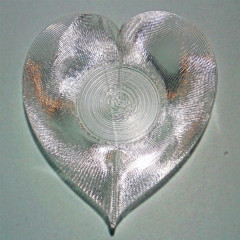Kanada, Y., Rapid Prototyping Journal, Vol. 22, No. 4, 2016.
[ 日本語のページ ]
[ Paper PDF file ]
[ Manuscript PDF file ]
Summarized abstract:
A methodology for designing and printing 3D objects with specified printing-direction using fused deposition modelling (FDM), which was proposed by a previous paper, enables the expression of natural directions, such as hairs, fabric, or other directed textures, in modelled objects. This paper aims to enhance this methodology for creating various shapes of generative visual objects with several specialized attributes.
The proposed enhancement consists of two new methods and a new technique. The first is a method for “deformation.” It enables deforming simple 3D models to create varieties of shapes much more easily in generative design processes. The second is the spiral/helical printing method. The print direction (filament direction) of each part of a printed object is made consistent by this method, and it also enables seamless printing results and enables low-angle overhang. The third, i.e., the light-reflection control technique, controls the properties of filament while printing with transparent PLA. It enables the printed objects to reflect light brilliantly.
...
Introduction to this research theme:
3D shape formation technologies
Structured abstract:
- Purpose
- A methodology for designing and printing 3D objects with specified printing-direction using fused deposition modelling (FDM), which was proposed by a previous paper, enables the expression of natural directions, such as hairs, fabric, or other directed textures, in modelled objects. This paper aims to enhance this methodology for creating various shapes of generative visual objects with several specialized attributes.
- Design/methodology/approach
- The proposed enhancement consists of two new methods and a new technique. The first is a method for “deformation.” It enables deforming simple 3D models to create varieties of shapes much more easily in generative design processes. The second is the spiral/helical printing method. The print direction (filament direction) of each part of a printed object is made consistent by this method, and it also enables seamless printing results and enables low-angle overhang. The third, i.e., the light-reflection control technique, controls the properties of filament while printing with transparent PLA. It enables the printed objects to reflect light brilliantly.
- Findings
- The proposed methods and technique were implemented in a Python library and evaluated by printing various shapes, and it is confirmed that they work well and objects with attractive attributes, such as the brilliance, can be created.
- Research limitations/implications
- The methods and technique proposed in this paper are not well-suited to industrial prototyping or manufacturing that require strength or intensity.
- Practical implications
- The techniques proposed in this paper are suited for generatively producing various a small number of products with artistic or visual properties.
- Originality/value
- This paper proposes a completely different methodology for 3D printing than the conventional CAD-based methodology and enables products that cannot be created by conventional methods.
